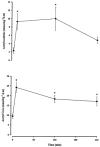Intramuscular triacylglycerol, glycogen and acetyl group metabolism during 4 h of moderate exercise in man
- PMID: 12068055
- PMCID: PMC2290362
- DOI: 10.1113/jphysiol.2002.018820
Intramuscular triacylglycerol, glycogen and acetyl group metabolism during 4 h of moderate exercise in man
Abstract
This study investigated intramuscular triacylglycerol (IMTG) and glycogen utilisation, pyruvate dehydrogenase activation (PDHa) and acetyl group accumulation during prolonged moderate intensity exercise. Seven endurance-trained men cycled for 240 min at 57 % maximal oxygen consumption (V(O2,max)) and duplicate muscle samples were obtained at rest and at 10, 120 and 240 min of exercise. We hypothesised that IMTG utilisation would be augmented during 2-4 h of exercise, while PDHa would be decreased secondary to reduced glycogen metabolism. IMTG was measured on both muscle samples at each time point and the coefficient of variation was 12.3 +/- 9.4 %. Whole body respiratory exchange ratio (RER) decreased from 0.89 +/- 0.01 at 30 min to 0.83 +/- 0.01 at 150 min and remained low throughout exercise. Plasma glycerol and free fatty acids (FFAs) had increased compared with rest at 90 min and progressively increased until exercise cessation. Although plasma glucose tended to decrease with exercise, this was not significant. IMTG was reduced at 120 min compared with rest (0 min, 15.6 +/- 0.8 mmol kg(-1) d.m.; 120 min, 12.8 +/- 0.7 mmol kg(-1) d.m.) but no further reduction in IMTG was observed at 240 min. Muscle glycogen was 468 +/- 49 mmol kg(-1) d.m. at rest and decreased at 120 min and again at 240 min (217 +/- 48 and 144 + 47 mmol kg(-1) d.m.). PDHa increased above rest at 10 and 120 min, but decreased at 240 min, which coincided with reduced whole body carbohydrate oxidation. Muscle pyruvate and ATP were unchanged with exercise. Acetyl CoA increased at 10 min and remained elevated throughout exercise. Acetylcarnitine increased at exercise onset but returned to resting values by 240 min. Contrary to our first hypothesis, significant utilisation of IMTG occurred during the first 2 h of moderate exercise but not during hours 2-4. The reduced utilisation of intramuscular fuels during the last 120 min was offset by greater FFA delivery and oxidation. Consistent with the second hypothesis, PDHa decreased late in moderate exercise and closely matched the estimates of lower carbohydrate flux. Although the factor underlying the PDHa decrease was not apparent, reduced pyruvate provision secondary to diminished glycolytic flux is the most likely mechanism.
Figures






Similar articles
-
Skeletal muscle fat and carbohydrate metabolism during recovery from glycogen-depleting exercise in humans.J Physiol. 2003 May 1;548(Pt 3):919-27. doi: 10.1113/jphysiol.2002.031179. Epub 2003 Mar 21. J Physiol. 2003. PMID: 12651914 Free PMC article.
-
Carbohydrate ingestion reduces skeletal muscle acetylcarnitine availability but has no effect on substrate phosphorylation at the onset of exercise in man.J Physiol. 2002 Nov 1;544(3):949-56. doi: 10.1113/jphysiol.2002.026757. J Physiol. 2002. PMID: 12411537 Free PMC article. Clinical Trial.
-
Pyruvate dehydrogenase activity and acetyl group accumulation during exercise after different diets.Am J Physiol. 1993 Nov;265(5 Pt 1):E752-60. doi: 10.1152/ajpendo.1993.265.5.E752. Am J Physiol. 1993. PMID: 8238502
-
Fuel selection, muscle fibre.Proc Nutr Soc. 1995 Mar;54(1):107-21. doi: 10.1079/pns19950041. Proc Nutr Soc. 1995. PMID: 7568245 Review.
-
Intramuscular triacylglycerol utilization in human skeletal muscle during exercise: is there a controversy?J Appl Physiol (1985). 2002 Oct;93(4):1185-95. doi: 10.1152/japplphysiol.00197.2002. J Appl Physiol (1985). 2002. PMID: 12235013 Review.
Cited by
-
Effects of dynamic exercise intensity on the activation of hormone-sensitive lipase in human skeletal muscle.J Physiol. 2003 Feb 15;547(Pt 1):301-8. doi: 10.1113/jphysiol.2002.034595. Epub 2002 Dec 20. J Physiol. 2003. PMID: 12562895 Free PMC article.
-
Intramyocellular lipid stores increase markedly in athletes after 1.5 days lipid supplementation and are utilized during exercise in proportion to their content.Eur J Appl Physiol. 2006 Nov;98(4):341-54. doi: 10.1007/s00421-006-0279-5. Epub 2006 Aug 11. Eur J Appl Physiol. 2006. PMID: 16902796 Clinical Trial.
-
Effects of IL-6 on pyruvate dehydrogenase regulation in mouse skeletal muscle.Pflugers Arch. 2014 Aug;466(8):1647-57. doi: 10.1007/s00424-013-1399-5. Epub 2013 Nov 14. Pflugers Arch. 2014. PMID: 24221357 Free PMC article.
-
The Key Role of Mitochondrial Function in Health and Disease.Antioxidants (Basel). 2023 Mar 23;12(4):782. doi: 10.3390/antiox12040782. Antioxidants (Basel). 2023. PMID: 37107158 Free PMC article. Review.
-
Associations of the Lipidome with Ageing, Cognitive Decline and Exercise Behaviours.Metabolites. 2022 Aug 31;12(9):822. doi: 10.3390/metabo12090822. Metabolites. 2022. PMID: 36144226 Free PMC article. Review.
References
-
- Bergman BC, Butterfield GE, Wolfel EE, Casazza GA, Lopaschuk GD, Brooks GA. Evaluation of exercise and training on muscle lipid metabolism. American Journal of Physiology. 1999;276:E106–117. - PubMed
-
- Bergmeyer HU. Methods in Enzymatic Analysis. New York: Academic Press; 1974.
Publication types
MeSH terms
Substances
LinkOut - more resources
Full Text Sources
Medical

